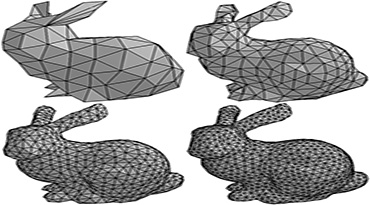
What is resolution?
All 3D models are made up of hundreds of thousands or even millions of points. Resolution is usually measured in millimeters (or microns) and is the smallest possible distance between any two given points within your 3D model. Therefore, the higher the resolution (points are closer together), the more points you need to visualize the same model. But also, the higher resolution, the more detail there is on the model.
Most 3D scanners capture as much data as possible during scanning, and resolution parameters are then set during post-processing in the software. So, let’s say we use the Drake Midi scanner to digitize an object.
Here is a model of garden vase (~63cm/25in in height):
If we post-process the model at 0.5mm (0.02in) resolution (maximum for Drake Midi) and then again at 0.7mm using the same raw data, we can see the difference in the detail of the model up close.
Resolution of 0.5mm Resolution of 0.7mm
And if we zoom-in even closer to look at the mesh, it is easy to see the difference.
At 0.5mm, the distance between each point is smaller, therefore, there are more points (also known as vertices), and thus, the model seems more “detailed”. At 0.7mm resolution, the model seems “smoother” and less intricate.
Why set a lower resolution? Wouldn’t you want the best possible results every time?
At the best possible resolution, your model will consist of many more points than it would at a lower setting. In the example above, at 0.5mm resolution, the final model “weighed” 307MB and had approximately 3 million points, whereas at 0.7mm resolution it consisted of 1.6 million points and weighed 157MB.
Since there is so much more data, the computer will take longer to finalize the model and the outcome will be noticeably “heavier” which might slow down other processes down the line (the 3D printer that will try to print it, or the CAD software that will try to use it augment the data). Depending on how you plan to use the 3D model, you must determine whether there is a need for such intricate detail.
When wouldn’t I need the maximum resolution?
There are many instances where the maximum resolution is not required and can slow down your work-flow unnecessarily. For example, if you are scanning a human to print a 3D selfie. The final 3D print will be around 20cm (7in) high, so you will most likely not see the wrinkles or the dimples on the person’s face. If that’s the case, why bog down your computer and your 3D printer with unnecessary data? For this application you wouldn’t need resolution higher than 1-3mm.
Another example, is when you want to reverse engineer a simple shape such as a table. It will have many flat, simple surfaces and you wouldn’t set high resolution because there is no need to see the scratches or the dings that have appeared on this piece of furniture over its lifetime. You just require simple dimensions such as the height and width of the legs.
Finally, there is always a limit to what even the most expensive computer can do. Imagine scanning a garbage truck (to outfit it with custom accessories later, for example) and trying to finalize the model at 0.5mm resolution. As I write this blog in early 2018, the most powerful commercially-available computer will take 1-2 days to post-process this data and chances are that there will be some buffer or memory error in the middle of the night at hour #31 and you will have to start all over. Most likely, the computer will either be unable to process it or you will give up trying.
Are there general rules of “thumb”?
Practically we recommend the following resolution settings:
|
Size of object (examples) |
Reasonable Resolution Settings |
|
Earring |
0.1mm-0.3mm |
|
Human lips |
0.2mm-0.4mm |
|
Human face |
0.5mm-1.0mm |
|
Human full body |
1.5mm-3mm |
|
Standard full scan of automobile |
3.0mm-4.0mm |
-- Anna ZevelyovDirector of SalesThor 3D
